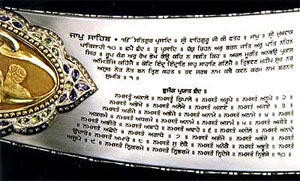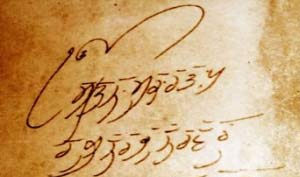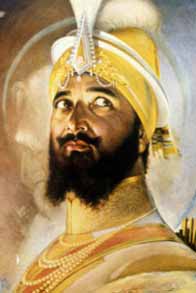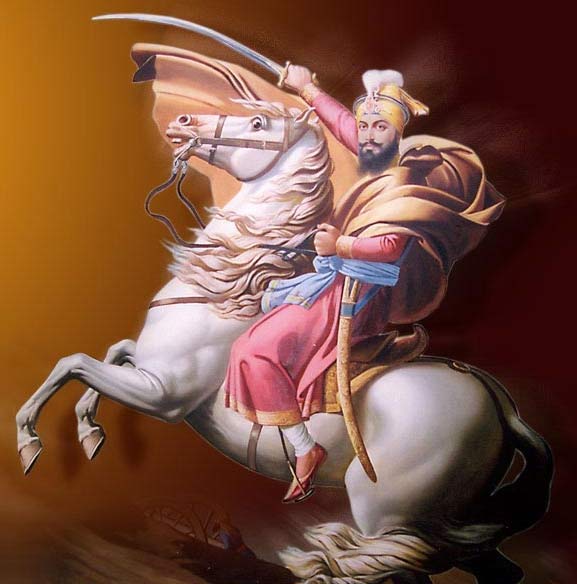Jaap Sahib
The Jaap Sahib was written by Guru Gobind Singh ji, the 10th Guru of the Sikhs. It is the opening bani of the Siri Dasam Granth Sahib, the compiled volume of Guru Gobind Singh’s writings. It is one of the Panj Bania, the daily Sikh prayers, and it is also one of the banis recited at the time of the Amrit Sanchar, the Sikh baptismal ceremony. The date of the Jaap Sahib’s creation is contested, but we believe it to be composed at Paonta Sahib in 1685 when the Guru was 19 years old. Jaap means to utter, or chant, and Guru Gobind Singh's Jaap Sahib is comprised of 199 verses, containing 950 descriptive names of the Formless Divine Being. Sometimes he describes God in negative terms defining what He is not, and other times he beautifully exalts the positive attributes of the One. “This turns the composition into a beautiful necklace in which the beads of positive and negative attributes of Reality have been so intimately and artistically joined together that, as a work of art, it becomes a rare specimen of the Guru’s vocabulary and poetic ingenuity.” Who can ever recite all Your Names! By reciting the earthly attributes of the One, in wave after wave, Guru Gobind Singh brings his Sikhs into an experience of God that transcends far beyond the rational faculty of man. The Jaap synthesizes the impersonal and the personal, the transcendental and the phenomenal, the Nirgun and Sargun aspects of the Formless One. The Jaap is a self-manifestation of God, a divine act of grace that offers to man that he does not have to understand God, but only to accept and adore Him. Jaap Sahib was written, not to be intellectually understood, but to be spiritually experienced. It is sophisticated in its poetic meter, which resembles the pounding of galloping horse hoofs; bringing the listener as well as the speaker to an experience of God. And that is the promise of Guru Gobind Singh.
“Once there were five holy men who appeared before God. The first one bowed and said, "You are Almighty God, my only God, I bow before you." God turned his head; it didn't work. The second one sat down and beautifully sang the praises of God. God put plugs in his ears. It didn't work either. The third started reciting poetry in praise of God. God looked at him and looked at him and did not utter a word. The fourth was very appreciative, delightful, singing beautiful hymns, in absolute perfect bhaktee but God just sat down and closed his eyes. The fifth looked at God, raised his hand and made a gesture of beckoning as if to say, ‘come here’. God got up and walked over to embrace him. You ask me why? Because God is God. Those who dwell in Him know it well. Those who don’t can talk the rest of their life without making sense.” When we recite the Jaap Sahib, we raise our arms to irresistibly beckon the Formless Supreme One. Join us in this divine celebration of Naad, and experience the promise of the 10th Master.
With genius and sensitivity, he created out of the common people the distinct order of the Khalsa, with uncommon form and symbols that gave them a unique identity in a crowd of millions. This bond still holds the Sikhs together today. He was a scholar of many languages and a writer of soul-stirring poetry. He was a warrior of the highest order, defending the people of India against cruel oppression and aggression. He embodied kindness and courage, meditation and action, the soldier and the saint in one amazing man the likes of whom the world has not witnessed before or after. He was a spiritual warrior of renowned skill, yet lived his life by the principles of love. Guru Gobind Singh believed and declared that he had come to the world with a mission to protect and help the good; and to chastise and uproot the evil-doers. This could be done only by leading an active life in the world, not in the yogic retreats of mountains and jungles, far away from the people. This was Guru Gobind Singh, both a teacher and a disciple – the real Khalsa – a saint and a soldier, a man of the world, and yet detached from it.
|
History - Donation - Sponsorships - Privacy - Help - Registration - Home - Search
Copyright © 1995 -2007, All Right Reserved



 Guru Gobind Singh, the 10th Guru of the Sikhs, has been loved and adored by millions of people for more than three hundred years. He was born at Patna in 1666, and spent the greater part of his life in the Punjab. He married and he had four beautiful sons. Guru Gobind Singh was a leader of his people, living amongst them, teaching and guiding them both by principle and by example. Guru Gobind Singh and all four of his children gave their lives fighting for the religious freedom of the people of India.
Guru Gobind Singh, the 10th Guru of the Sikhs, has been loved and adored by millions of people for more than three hundred years. He was born at Patna in 1666, and spent the greater part of his life in the Punjab. He married and he had four beautiful sons. Guru Gobind Singh was a leader of his people, living amongst them, teaching and guiding them both by principle and by example. Guru Gobind Singh and all four of his children gave their lives fighting for the religious freedom of the people of India.